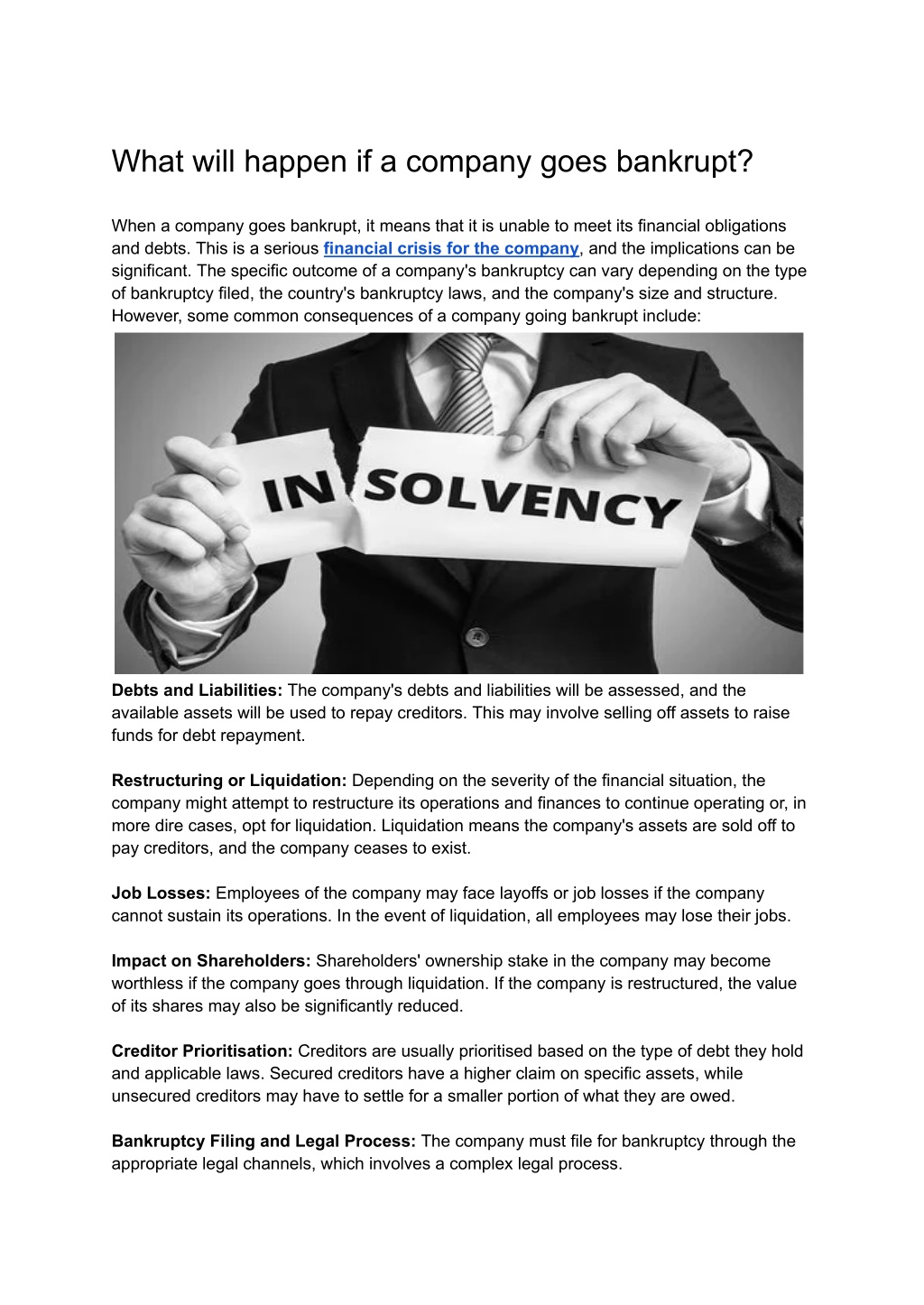In-Depth Overview to Company Administration: Ramifications When a Company Goes into Liquidation
In-Depth Overview to Company Administration: Ramifications When a Company Goes into Liquidation
Blog Article
The Refine and Effects of a Business Entering Administration
As a firm faces monetary distress, the choice to get in management marks a critical juncture that can have significant ramifications for all included celebrations. The procedure of going into administration is detailed, entailing a series of actions that aim to navigate the business towards possible recovery or, in some instances, liquidation.
Summary of Business Administration Process
In the realm of company restructuring, a crucial first step is obtaining a comprehensive understanding of the complex company management process. Firm management describes the formal bankruptcy treatment that aims to rescue a financially troubled firm or achieve a far better outcome for the business's financial institutions than would be feasible in a liquidation circumstance. This process entails the consultation of a manager, who takes control of the business from its directors to assess the monetary scenario and establish the most effective training course of action.
Throughout administration, the business is given protection from lawsuit by its creditors, offering a postponement duration to formulate a restructuring strategy. The manager works with the business's monitoring, financial institutions, and various other stakeholders to design a strategy that might entail marketing the service as a going issue, getting to a company voluntary arrangement (CVA) with creditors, or eventually putting the business into liquidation if rescue efforts verify futile. The main objective of company administration is to optimize the go back to financial institutions while either returning the company to solvency or shutting it down in an orderly way.

Functions and Duties of Administrator
Playing a pivotal function in supervising the company's decision-making procedures and financial events, the manager presumes considerable obligations throughout the company restructuring procedure. The key responsibility of the manager is to act in the very best passions of the company's lenders, aiming to attain the most desirable result feasible - company administration uk. This entails carrying out a complete assessment of the firm's financial situation, establishing a restructuring strategy, and implementing methods to take full advantage of go back to financial institutions
Additionally, the administrator is liable for liaising with various stakeholders, consisting of staff members, suppliers, and regulative bodies, to make certain transparency and conformity throughout the management process. They need to additionally communicate properly with shareholders, offering normal updates on the company's progression and seeking their input when required.
Furthermore, the administrator plays a critical duty in handling the everyday operations of the service, making crucial decisions to preserve continuity and preserve worth. This consists of reviewing the practicality of different restructuring alternatives, discussing with financial institutions, and ultimately guiding the company towards an effective exit from management.
Effect on Firm Stakeholders
Thinking an important setting in managing the company's economic affairs and decision-making processes, the administrator's actions during the company restructuring procedure have a direct effect on numerous firm stakeholders. Investors may experience a decrease in the value of their financial investments as the firm's economic problems are dealt with. Lenders, consisting of lenders and vendors, may encounter unpredictabilities pertaining to the settlement of financial obligations owed to them. Workers commonly run into task instabilities due to potential discharges or modifications in work problems as part of the restructuring efforts. Clients might experience disturbances in services or product accessibility throughout the administration procedure, affecting their trust and commitment towards the business. In addition, the neighborhood where the business runs can be influenced by potential job losses or modifications in the business's operations, affecting local economic climates. Reliable interaction from the manager to stakeholders is critical in handling expectations, reducing problems, and fostering openness throughout the management procedure.
Legal Effects and Obligations
During the process of firm administration, careful consideration of the legal effects and responsibilities is paramount to make sure compliance and secure the rate of interests of all stakeholders entailed. When a firm goes into administration, it activates a set of legal needs that must be stuck to.
In addition, lawful effects arise concerning the treatment of workers. The administrator should adhere to employment legislations regarding redundancies, employee rights, and responsibilities to offer necessary details to staff member agents. Failure to adhere to these lawful demands can result in lawsuit against the business or its administrators.
Additionally, the business going into administration may have contractual commitments with numerous parties, consisting of distributors, landlords, and customers. These contracts require to be evaluated to identify the most effective course of action, whether to terminate, renegotiate, or satisfy them. Failing to handle these legal responsibilities appropriately can bring about disagreements and possible legal check this site out repercussions. Essentially, understanding and meeting legal commitments are crucial elements of navigating a firm via the administration procedure.
Techniques for Business Recovery or Liquidation
In considering the future instructions of a business in management, tactical preparation for either recovery or liquidation is vital to chart a practical path onward. When aiming for company recovery, vital methods might consist of conducting a comprehensive evaluation of the business operations to determine inefficiencies, renegotiating contracts or leases to boost capital, and applying cost-cutting actions to enhance earnings. In addition, looking for new financial investment or funding choices, branching out earnings streams, and concentrating on core expertises can all add to a successful recovery strategy.

Conclusion
In verdict, the process of a business getting in management entails the consultation of a manager, that takes on the responsibilities of taking care of the firm's events. This process can have considerable effects for numerous stakeholders, consisting of staff members, financial institutions, and investors. It is crucial for why not try here business to carefully consider their choices and techniques for either recouping from economic problems or waging liquidation in order to minimize prospective lawful effects and commitments.
Business administration refers to the formal insolvency treatment that intends to rescue a financially troubled firm or accomplish a far better outcome for the business's financial institutions than would certainly be possible in a liquidation scenario. The administrator works with the company's administration, creditors, and other stakeholders to devise a strategy that might include offering the business as a going concern, reaching a business voluntary arrangement (CVA) with lenders, or inevitably positioning the firm into liquidation if rescue efforts show useless. The main goal of firm management is to maximize dig this the return to creditors while either returning the business to solvency or shutting it down in an orderly fashion.
Presuming an important placement in supervising the business's decision-making processes and economic affairs, the administrator's activities during the business restructuring process have a straight influence on various business stakeholders.In conclusion, the process of a business going into management includes the visit of a manager, who takes on the duties of managing the company's events.
Report this page